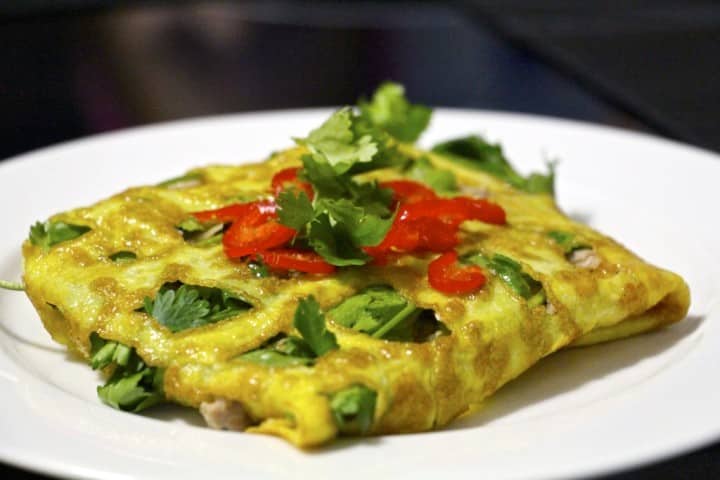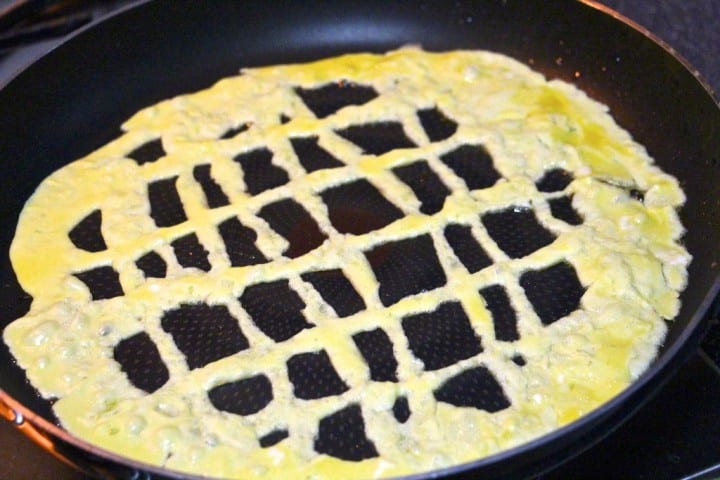
Brian Kennett
Amateur Chef and Boozy Traveling Foodie Extraordinaire
Best Thai Egg Baskets Recipe: ding dong, stunning!!!
Best Thai Egg Baskets Recipe: is complex. Get your steady hands ready for this recipe. This is one of the trickier recipes I have ever written for you guys to make. But still please have a go, as it is so nice when you finish them as I think you’ll agree with the photo.
Table of Contents

I think that looks absolutely stunning!!!
This is a Thai recipe, that I have messed about with a bit. It really has now become the Best Thai Eggs Recipe. In Thailand, they’ll have a special dispenser that is cone-shaped to draw out the egg basket crisscross. I simply used an oil dispenser as that worked as a dream to create my Thai Egg Baskets.
I made 4 big Thai Egg Baskets for my gang with the following ingredients and had just about enough left over to make one more. So as a main course dish, this will comfortably be enough for 4, or if making this as a starter you’ll easily get 8 from these ingredients;
Filling;
- 4 roughly chopped coriander roots (buy the Chinese parsley at your supermarket to get the roots on still);
- 3 cloves of roughly chopped garlic;
- A good pinch of cracked black pepper;
- A good pinch of sea salt;
- 2 roughly chopped small red onions;
- 3-400g of minced pork, or chicken – or even a mix of the both;
- 5 tablespoons of crushed-up roasted peanuts;
- 1 tablespoon of palm sugar or equivalent (brown sugar);
- 1-2 tablespoons of fish sauce (to your personal taste); and
- 1-2 teaspoons of lime juice.
Baskets;
- 6 beaten eggs;
- 2 teaspoons of Soya sauce, and 2 teaspoons of fish sauce into the beaten egg mix;
- A handful of chopped coriander and some sliced red chili for garnish.
- In a pestle and mortar bash up the garlic, coriander roots, pepper, and salt. You want to bash that to a paste. You’ll smell this immediately as you bash it – this is going to be good, believe me;
- Heat up your wok, splash in some oil, and add in the paste you just made. Now fry this off very briefly just to release the fragrance;
- Add in the meat, and the onions and fry off until the meat is cooked through;
- Add in the peanuts, palm sugar, salt, lime juice, and fish sauce;
- Keep cooking this until the liquid thickens a little.
- All good on your filling. So off the heat and stand this aside whilst we move the tricky little baskets.
You will need a squeeze bottle or an oil dispenser as you really do need thin thin egg lines or ‘stripes’ across the pan. See below one of mine well underway. Basically, all I did was make a circle and then cross it horizontally and vertically – you need to be quick as it is thin and will cook very fast. Flip it if you need, but I found because it was so thin it cooked through from the bottom to the top with no need to flip. Amazing! Loving this Best Thai Egg Baskets Recipe.

Draw a circle then go criss-cross on the vertical and horizontal – this is your basket.
- Once it is browned on one side slip it onto a chopping board or worktop;
- Add a good bunch of coriander leaves in the middle of the basket as this will give a lovely fragrance and fresh herb punch when you bite it;
- Spoon on 3-4 tablespoons of the meat filling on top of the leaves;
- Then turn in the edges of the omelette to make a neat square;
- I then placed an overturned plate on top of this square, and flipped the board upside down;
- Tah Dah there is your Thai Egg Basket ready for garnishing on the plate.
Conclusions of Best Thai Egg Baskets Recipe
I simply sprinkled a few chopped chilies and a coriander leaf or two. Job done. Serve it up – and receive the “oooohs!” It’s impressive in looks and flavor – believe me! This Best Thai Egg Baskets Recipe is just amazing to look at and to eat. Just so very tasty, all the things I love about Thai food in one little eggbasket. Salty, sour, sweet, spicy… ENJOY!!!
What is Thai food?
Food from Thailand is an exploration of flavors and seasonings. It is, without a doubt, some of my favorite foods on the planet, and I have copious amounts of Thai cookbooks. How can you not love the Thai combinations of; salty, sour, spicy, sweet… Gets my vote every day of the week.
When we think about Thai cuisine, the meals that come to mind typically have strong flavors, vivid colors, and a harmonious combination of sweet, sour, salty, and spicy components. In recent years, Thai cuisine has attained an ever-increasing level of popularity all over the world, and for good reason. It offers a gastronomic experience that is both rich and varied, and it is a reflection of the country’s history, culture, and geography.
Also, having international Chef Ambassadors like David Thompson really help with awareness, especially when getting Michelin Stars… likely my 2 favorite Thai CookBooks, are Chef Thomspon’s.
Overview of the Development of Thai Cuisine
The cuisine of Thailand has been shaped by its neighbors, including China, India, and Malaysia, as well as by the traders and colonizers from Europe and the Middle East who passed through the region. These many culinary traditions, along with Thai ingredients and cooking methods, have been influenced by one another throughout the course of time, resulting in the singular and delectable cuisine we are familiar with today.
The use of fresh herbs and spices, which are fundamental to the culinary history of Thailand, is perhaps one of the most recognizable characteristics of Thai cuisine. There are a wide variety of herbs that are utilized frequently in Thai cuisine. Some of these herbs include coriander, lemongrass, galangal, and kaffir lime leaves. To give the recipes more dimension and nuance, key ingredients such as chile, ginger, and turmeric are also included.
Different Varieties of Thai Food
Northern cuisine, Northeastern (Isan) food, Central cuisine, and Southern cuisine are the four distinct regional styles that make up Thai cuisine. Although the ingredients and meals of each location are distinct from one another, they always adhere to the principle of using fresh, robust tastes.
Sticky rice and a wide range of herbs and vegetables are both essential components of the cuisine of Northern Thailand, which is influenced by the neighboring countries of Myanmar and China due to the region’s milder climate. Sai ua is a spicy sausage prepared with lemongrass and other herbs, and it is one of the most popular meals in Thailand. Khao soi is a noodle soup that is served with creamy coconut milk curry.
Isan, which is located in Northeastern Thailand, is renowned for its flavors that are hot and sour. Dishes such as som tam, which is a spicy green papaya salad, and larb, which is a minced meat salad with lime and chili, are very popular. Sticky rice and grilled meats are also very frequent.
The most varied culture and cuisine may be found in Central Thailand, which also happens to be the location of the country’s bustling capital city, Bangkok. Pad thai, a stir-fried noodle dish with sweet and sour characteristics, and tom yum goong, a sour and spicy soup with shrimp, are both popular dishes that can be found in Thai restaurants.
The Southern region of Thailand is well-known for its seafood as well as its curries, which are frequently prepared with coconut milk and spice. Popular dishes include gaeng som, which is a sour curry prepared with tamarind and fish, and massaman curry, which is a thick and savory curry with potatoes and peanuts. Both of these curries can be found in most Thai restaurants.
Mainstays of Thai Cooking
There are a few essentials that are likely to be found across Thailand regardless of where you travel in the country. Rice is the most essential food in Thai cooking, and it is customary to include it in each and every one of the country’s meals. Noodles, such as rice noodles and egg noodles, are also quite common in Thai cuisine. Dishes such as pad thai and khao soi make use of these noodles.
Fish sauce, which lends many meals a salty and savory flavor, is another essential component in Thai cooking. This sauce is made from fermented fish and other seafood. To counteract the salty and spicy qualities, palm sugar, tamarind, and lime juice are frequently added as complementary ingredients.
Last but not least, chile peppers are an essential part of Thai cuisine and should be mentioned at some point throughout this conversation. The dishes that make up Thai cuisine are notorious for their high level of spiciness and are typically prepared with either fresh chili peppers or dried chili flakes. Curry and stir-fry dishes frequently call for chili paste as an essential component of their flavor.
Conclusion
The culinary legacy of Thailand is one that is alive and fascinating, and it features an extensive range of flavors and meals to choose from. Thai cuisine is a journey through flavors and spices that highlights the country’s rich cultural heritage from the days of Siam. It ranges from fiery curries to sour salads and everything in between. Whether you’re a seasoned foodie or a curious beginner, your taste buds are sure to be delighted by Thai cuisine, and you’ll definitely be left wanting more. It really is some of the very best food on this planet.
How to make Thai Fish Sauce?
The traditional method for producing Thai fish sauce, commonly referred to as nam pla, involves fermenting small fish, typically anchovies, with salt. The following is an example of a simple recipe for producing Thai fish sauce:
- Begin with young fish that are on the smaller side, such as anchovies.
- In order to eliminate any contaminants from the fish, give it a quick rinse in some cold water.
- Layer the fish in a jar or other container; fish, then salt, and then fresh pineapple, and repeat until the jar is full (the acid in the pineapple assist with breaking down the fish).
- The fish and salt mixture should be allowed to rest at room temperature for several months while being stirred on periodically.
- After a period of time, the mixture will have been able to ferment, resulting in the production of a liquid that will become the fish sauce.
- Remove any particles or other contaminants from the sauce by passing it through a strainer with a fine mesh.
- Note that this is only the basic recipe for fish sauce.

